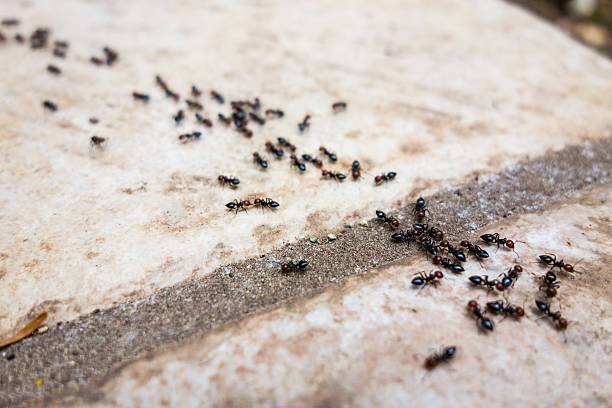HabitatThey prefer to nest outdoors in soil or decayed logs. They build mounds of soil, leaves, twigs, pine needles, or other plant materials. They usually nest in sunny areas near trees, shrubs, fences, foundations, or rocks. Field ants rarely nest indoors, but they may enter houses in search of food or shelter.
DietField ants feed on a variety of foods, including insects, seeds, nectar, honeydew, and sometimes other ants. They have two stomachs, one for storing food and one for digesting it. They use pheromones to communicate and find food sources. Their diet may change depending on the season and their reproductive needs. They can carry more than 10 times their weight.
Life Cycle and ReproductionField ants have four stages in their life cycle: egg, larva, pupa, and adult. The reproduction starts with the mating of winged males and virgin queens, after which the female never mates again. The queen lays eggs that hatch into larvae in about a week. The larvae go through several stages of growth and depend on the workers for food. The larvae transform into pupae and develop into adults in a few weeks. The adults are either queens, workers, or soldiers, and have different roles in the colony. The life cycle takes around 6 to 10 weeks depending on the species and the environment.
PreventionThere are some steps that homeowners can take to prevent field ants from nesting on their property. These include:
Storing firewood at least 15 feet away from the house
Avoiding having any mulch placed right up against the foundation of the home
Keeping shrubbery well-trimmed
Closing exterior doors tightly and replacing any damaged or missing weather stripping
Sealing any cracks or gaps in the walls or foundation
Cleaning up any food crumbs or spills inside and outside the house
ControlThey are not usually considered pests, but they can become a nuisance or cause damage to the landscape if their colonies are large or aggressive. The best way to control field ants is to locate and treat their nests directly with an insecticide. Complete saturation of the nest is necessary because the queen may be living deep underground, and it is critical that she is killed to eliminate the colony. Some insecticides that can be used for field ant control are cyfluthrin, deltamethrin, bifenthrin, carbaryl (Sevin), or permethrin. Hot water and borax are not effective for control of field ants. If homeowners are unsure about how to identify or treat field ant infestations, they should contact a licensed pest control professional for assistance.
When to call a field ant exterminator ?The best is to call us as soon as possible. We service the Greater Toronto Area, call us now 647 849 4441
Call us to speak with our experienced field ant exterminator
GTA Exterminators for field ant removal in Toronto
Call us today for field ant extermination


